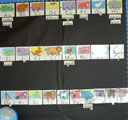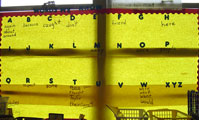Word
Walls
Word walls are collections of words that are support the development
of students' independent and strategic reading and writing. Word
walls are a helpful visual record of students' learning that can
also serve
as a quick reference when students get "stuck" on a word
while reading or writing. When used effectively, word walls can
be the core of a systematic phonics and spelling program (Brabham & Villaume,
2001).
Different types of word walls
- High-frequency sight words -- arranged
alphabetically. New words introduced at a rate of 3 to 5 per
week.
- Word
family word wall -- groups of words organized by word families,
including words built during Making Words.
- Graffiti wall -- words
that teachers or students find interesting in their own reading;
these may be organized alphabetically
or randomly.
- Content area word walls -- words from math,
science, social studies, or other units of study
- Frequently misspelled
words, including homophones and contractions
- Words with specific
spelling patterns, such as vowel digraphs, prefixes, or suffixes
Don't just "have" a word wall -- "Do" the
word wall!
Cunningham (2005) reminds us that many teachers "have" a
word wall. But - for struggling readers, having a word wall is
not sufficient. You have to "do" a word wall. "Doing" a
word wall means:
- Being selective and limiting the words to those
really common words that children need a lot in their writing
- Adding
words gradually - five a week max
- Making the words visually accessible
and attractive. Write the words in large black letters and
use a variety of colors
so that
commonly
confused words (from, for, that, they, this) look different
- Practicing
the words by chanting and writing them
- Incorporating frequent word-wall
activities in literacy instruction to support students' independent
and interactive
use of the word
wall (see below for ideas)
- Insisting that word-wall words
are spelled correctly in any writing students do
Making the most of the word wall
- Show students how to use the word
wall as tool to support their reading and writing. Plan activities
that invite students to
develop deeper
understandings of the relationship between letters and
sounds. Teach mini-lessons that explicitly demonstrate how to use
word
parts as clues
for word identification and spelling (see chunking and
decoding-by-analogy). The goal is to use the word wall as a scaffold
to help students
develop their sight word and word identification knowledge
(Gaskins, 2005).
- Encourage strategic use of the word walls during
individual conversations. Instead of telling a student how
to spell a
word, demonstrate how
you use the word wall to find similar words or remember
previously learned
spelling strategies. Strategic conversations can scaffold
students' development of chunking and decoding-by analogy strategies
used by skillful readers.
- Use the word wall as a springboard
for word study activities, including word sorts, word searches,
flash card games, making
words, and problem-solving
conversations about spelling and word identification.
- Use
the word wall as a "sponge" activity -- When you
have five minutes before lunch, play "I spy" or other
games using word wall words. For example, "I spy… a
four letter word that rhymes with mat." Encourage children
to make up riddles for one another using word-wall words.
"Portable" Word Walls for Struggling Readers
In addition
to explicit instruction and modeling in how to use the classroom
word wall, students who experience difficulty with
words
may benefit most from a personalized word wall. "Portable" word
walls (Cunningham, 2005) may take the form of a file folder
with space designated for words under each letter of the alphabet.
They are designed
to travel with students wherever they go, such as the reading
specialist's classroom and home at night.
What it Looks Like

Second
Grade Word Wall
|

Third Grade Word Wall
|

Third
Grade Word Wall
|
Click on any picture to see a larger version
Word Wall Instructional
Activities
"On the Back" activities - Children use word wall words to make
new words and extend their thinking about the words
http://www.k111.k12.il.us/lafayette/fourblocks/on_the_back_activities.htm
Word
Wall Chants
http://www.k111.k12.il.us/lafayette/FourBlocks/word_wall_chants.htm
Word
Wall "Active-ities:" Build Vocabulary, Spelling, and
Writing Skills: Five fun ideas to reinforce word wall words
http://www.education-world.com/a_lesson/lesson/lesson328.shtml
Word
Wall Resource page -- More word wall activity ideas and how-to
resources
http://www.education-world.com/a_lesson/lesson/lesson328b.shtml
 Teacher
Tips Teacher
Tips
How do you use word walls in your class? Submit your ideas
here!
Resources and Links
Websites
Interactive Word Wall: Comprehensive description accompanied
by 24 activities designed to make the word wall an interactive
instructional
tool
http://www.teachnet.com/lesson/langarts/wordwall062599.html
Kathy
Gurskey's Interactive Word Wall page: A teacher's description of
how she used word walls in her classroom.
Includes pictures!
http://www.theschoolbell.com/Links/word_walls/words.html
Word Wall
Lists from the Kankakee School District: Downloadable lists and
materials
http://www.k111.k12.il.us/LAFAYETTE/FOURBLOCKS/word_wall_grade_level_lists.htm
Reading
Assessment: Word Identification -- Includes the Dolch and Fry word
lists and an online demonstration
of a running
record.
http://wilearns.state.wi.us/apps/default.asp?cid=91
Books
Phonics They Use: Words for Reading and Writing (3rd
Ed.) by Patricia Cunningham (Pearson, 2005).
Articles
How Primary Teachers are Using Word Walls to Teach
Literacy Strategies by Mary Rycik (Ohio
Reading Teacher)
This article describes different types of word walls
and the ways that teachers were observed using them
in their
K-3 classrooms.
http://www.findarticles.com/p/articles/mi_qa4064/is_200207/ai_n9098510
References
Brabham, E. G. & Villaume, S. K. (2001). Building
walls of words. The Reading Teacher, 54, 700-702.
Cunningham, P.
(2005) Phonics they use: Words for reading and writing. Boston,
MA: Pearson.
Gaskins, I. (2005).Success with struggling readers:
The Benchmark School approach. New York: The Guilford
Press.
Rasinski, T. & Padak, N. (2004). Effective
reading strategies: Teaching children who find
reading difficult (3rd ed.). Columbus,
OH: Pearson.
Wagstaff, J. M. (1997/1998). Building
practical knowledge of letter-sound correspondences: A beginner's
Word
Wall and beyond.
The Reading
Teacher, 51, 298-304.
|







